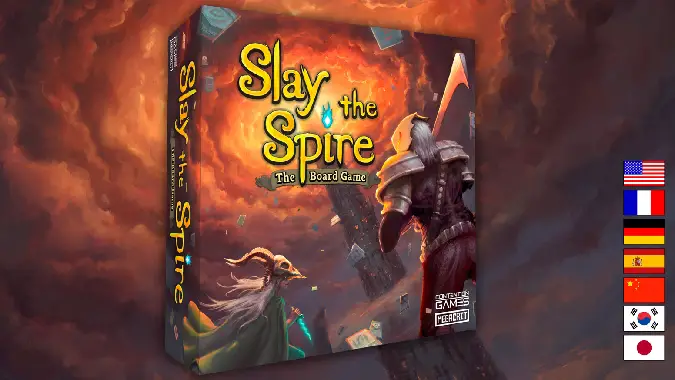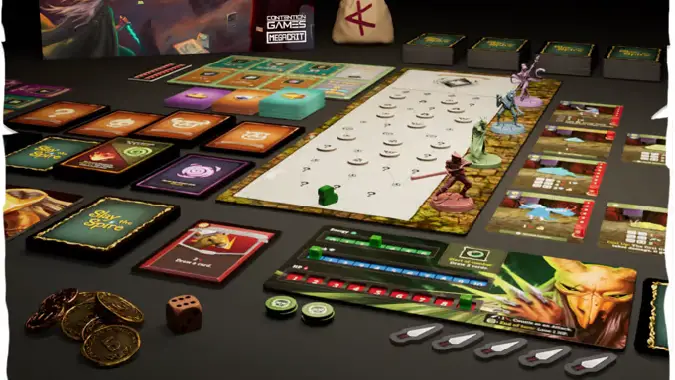The Slay the Spire board game lets you deck build with friends (without even turning on your computer)

Perhaps you’ve heard of Slay the Spire. For some time, it’s been an incredibly popular video game, a staple of the rogue-lite deck-building genre. In it, there’s a Spire, and your job is to climb it and slay its master. Along the way, you’ll build a unique deck of abilities, encounter bizarre creatures, and discover relics of immense power. But… did you know there’s a Slay the Spire board game? One that you can play with friends? Let’s talk about it, shall we?
Fundamentally, Slay the Spire is a deck-building game, where you use that deck to fight monsters of various stripes. Each card in your deck represents an ability of your character, a move that they can make. Some do damage to enemy creatures, some protect you from incoming attacks, and some do more exotic things. Every card costs energy in order to play, and you get three energy at the start of every round of combat. With this limited pool of resources, you’re generally forced to make some hard decisions about which cards to play in order to defeat the challenges in front of you while minimizing the damage you take in the process. Your character’s health is painfully finite and healing is hard to come by, so protecting yourself is critical if you want to make it all the way to the top of the Spire in your run.
As with the video game version, there are four character classes that you can play in the Slay the Spire board game:
- The Ironclad, a strong and grizzled warrior capable of dealing big sword hits and increasing his strength. The Ironclad starts with a slightly larger health pool than the other classes and regenerates a small amount of health at the end of each battle, handy for sure.
- The Silent, a sneaky rogue who generally prefers to inflict an overwhelming number of smaller hits. The Silent draws a couple of extra cards at the start of each battle and has the ability to accumulate shivs: small, free attacks that they can store up and unleash on enemies when it’s most advantageous.
- The Defect is a magic-using robot of sorts, who can channel the energy of lightning, frost, and darkness to devastating effect. They store this energy in the form of orbs which pulse at the end of every round of combat, or can be consumed for a larger immediate effect.
- The Watcher, a priest-like character who fluctuates between emotions of wrath and calm to strike down those that oppose them. Depending on how they’re feeling, they may do more damage at the cost of being hurt at the end of the round, or they may recover precious energy.
Whichever character class you pick to play, you start the game in a fight. With just a handful of Strike and Defend cards, as well as a card or two unique to your class, you face the guardians of the Spire’s entryway. Should you emerge triumphant, you get to start building your deck for real. Every combat features a card reward, where you draw three new cards from the top of your class’s reward deck and choose one of them to keep, as well as some gold and/or a single-use potion.
Then you start climbing the Spire. At each step in your climb, you may encounter more monsters, random events, restful campsites, dubious merchants, or, most rewardingly, terrifying elite creatures that cough up powerful relics upon defeat. At the top of your climb, you face off against one of three bosses for your current act. If you survive, you acquire an even more powerful and potentially build-defining boss relic, receive a rare card reward, and advance to the next act. This continues until you emerge triumphant at the top of the Spire, or until any player runs out of health.

Image courtesy of Contention Games
If you’re reading all this and thinking “wow, this sounds really familiar,” then you’re not wrong. The board game version of Slay the Spire plays and feels like the video game version in a lot of good ways. There are some critical differences, though.
The first is the numbers tuning. All the damage and health numbers have been scaled down to better accommodate manual tracking. Players’ maximum health, for example, is generally a whopping nine, and that doesn’t go up. Monster health is similarly scaled down, though with enough players you can definitely still find critters with health pools of over a hundred; those are just generally limited to powerful elite creatures and bosses. There are a few mechanical changes to the classes as well, to simply play. The Defect’s orbs, for instance, can be evoked in whatever order you like, rather than the fixed queue of the video game. And the Watcher’s wrath stance is less prone to make her spontaneously explode.
The biggest change to how the game plays by far, though, comes from the fact that it’s a multiplayer romp now. In combat, all the players each face off against their own set of creatures; monsters in a row will only attack that row’s player, but players are free to attack whatever critters they like. This allows for much greater tactical choice in terms of which player is attacking what. Do you all take on your own rows individually, or is it worth it to have everyone dogpile one player’s row to eliminate it quickly and take the incoming damage pressure off of that player? Choose wisely, though, because if any player character dies, it’s game over for everyone. In addition, all character classes are unlocked from the beginning to allow up to four people to play at once; you don’t have to unlock them one at a time like in the video game, though you do still get to unlock certain cards for them depending on how far you progress in your runs.
Personally, I’ve gotten to play the Slay the Spire board game a few times now, and I actually find that I enjoy it significantly more than I do the video game. Being multiplayer, and getting to play with friends who are a lot better at the game than I am, makes a huge difference in my enjoyment of the experience. Sure, I wish I didn’t have to manually shuffle my deck every time my discard pile fills up, but that feels like a small price to pay. My main word of caution is to be careful when doing that shuffling, however, as the card sleeves that the game comes with are prone to tearing if you accidentally get one card stuck in another card’s sleeve.
In short, the Slay the Spire board game is a great experience for both new and seasoned players, and the addition of multiplayer is a huge game-changer for it. It’s being published by Contention Games, and is currently available for pre-order, with a retail release date targeted for July 25.
Please consider supporting our Patreon!
Join the Discussion
Blizzard Watch is a safe space for all readers. By leaving comments on this site you agree to follow our commenting and community guidelines.




